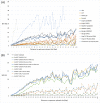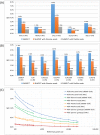Comparison of phasing strategies for whole human genomes
- PMID: 29621242
- PMCID: PMC5903673
- DOI: 10.1371/journal.pgen.1007308
Comparison of phasing strategies for whole human genomes
Abstract
Humans are a diploid species that inherit one set of chromosomes paternally and one homologous set of chromosomes maternally. Unfortunately, most human sequencing initiatives ignore this fact in that they do not directly delineate the nucleotide content of the maternal and paternal copies of the 23 chromosomes individuals possess (i.e., they do not 'phase' the genome) often because of the costs and complexities of doing so. We compared 11 different widely-used approaches to phasing human genomes using the publicly available 'Genome-In-A-Bottle' (GIAB) phased version of the NA12878 genome as a gold standard. The phasing strategies we compared included laboratory-based assays that prepare DNA in unique ways to facilitate phasing as well as purely computational approaches that seek to reconstruct phase information from general sequencing reads and constructs or population-level haplotype frequency information obtained through a reference panel of haplotypes. To assess the performance of the 11 approaches, we used metrics that included, among others, switch error rates, haplotype block lengths, the proportion of fully phase-resolved genes, phasing accuracy and yield between pairs of SNVs. Our comparisons suggest that a hybrid or combined approach that leverages: 1. population-based phasing using the SHAPEIT software suite, 2. either genome-wide sequencing read data or parental genotypes, and 3. a large reference panel of variant and haplotype frequencies, provides a fast and efficient way to produce highly accurate phase-resolved individual human genomes. We found that for population-based approaches, phasing performance is enhanced with the addition of genome-wide read data; e.g., whole genome shotgun and/or RNA sequencing reads. Further, we found that the inclusion of parental genotype data within a population-based phasing strategy can provide as much as a ten-fold reduction in phasing errors. We also considered a majority voting scheme for the construction of a consensus haplotype combining multiple predictions for enhanced performance and site coverage. Finally, we also identified DNA sequence signatures associated with the genomic regions harboring phasing switch errors, which included regions of low polymorphism or SNV density.
Conflict of interest statement
I have read the journal’s policy and the authors of this manuscript have the following competing interests: EK is an employee of Human Longevity, Inc. and holds stock in the company. NJS has stock options in Human Longevity, Inc.
Figures






References
-
- Goodwin S, McPherson JD, McCombie WR. Coming of age: ten years of next-generation sequencing technologies. Nat Rev Genet. 2016;17: 333–351. doi: 10.1038/nrg.2016.49 - DOI - PMC - PubMed
-
- MacArthur J, Bowler E, Cerezo M, Gil L, Hall P, Hastings E, et al. The new NHGRI-EBI Catalog of published genome-wide association studies (GWAS Catalog). Nucleic Acids Res. 2017;45: D896–D901. doi: 10.1093/nar/gkw1133 - DOI - PMC - PubMed
-
- Lazaridis KN, McAllister TM, Babovic-Vuksanovic D, Beck SA, Borad MJ, Bryce AH, et al. Implementing individualized medicine into the medical practice. Am J Med Genet C Semin Med Genet. 2014;166C: 15–23. doi: 10.1002/ajmg.c.31387 - DOI - PubMed
-
- Yang X, Chockalingam SP, Aluru S. A survey of error-correction methods for next-generation sequencing. Brief Bioinform. 2013;14: 56–66. doi: 10.1093/bib/bbs015 - DOI - PubMed
-
- Carvalho CMB, Lupski JR. Mechanisms underlying structural variant formation in genomic disorders. Nat Rev Genet. 2016;17: 224–238. doi: 10.1038/nrg.2015.25 - DOI - PMC - PubMed
Publication types
MeSH terms
Grants and funding
LinkOut - more resources
Full Text Sources
Other Literature Sources

